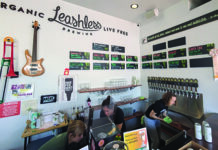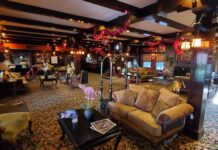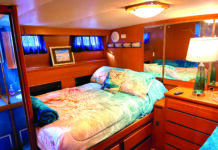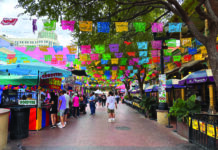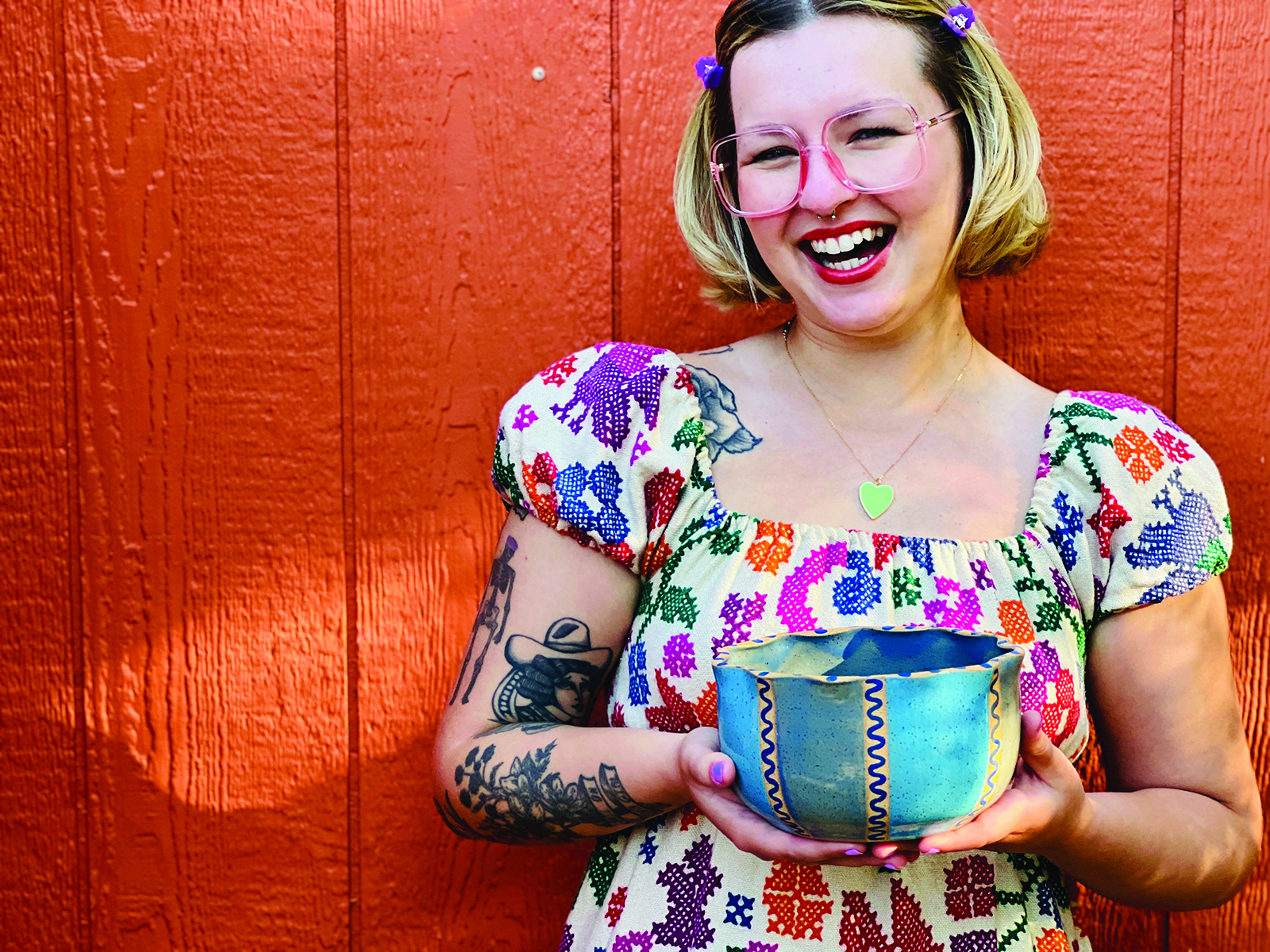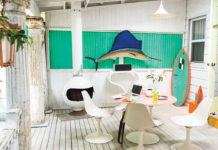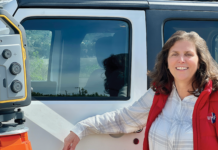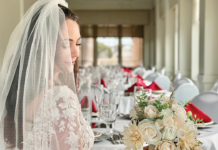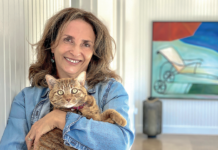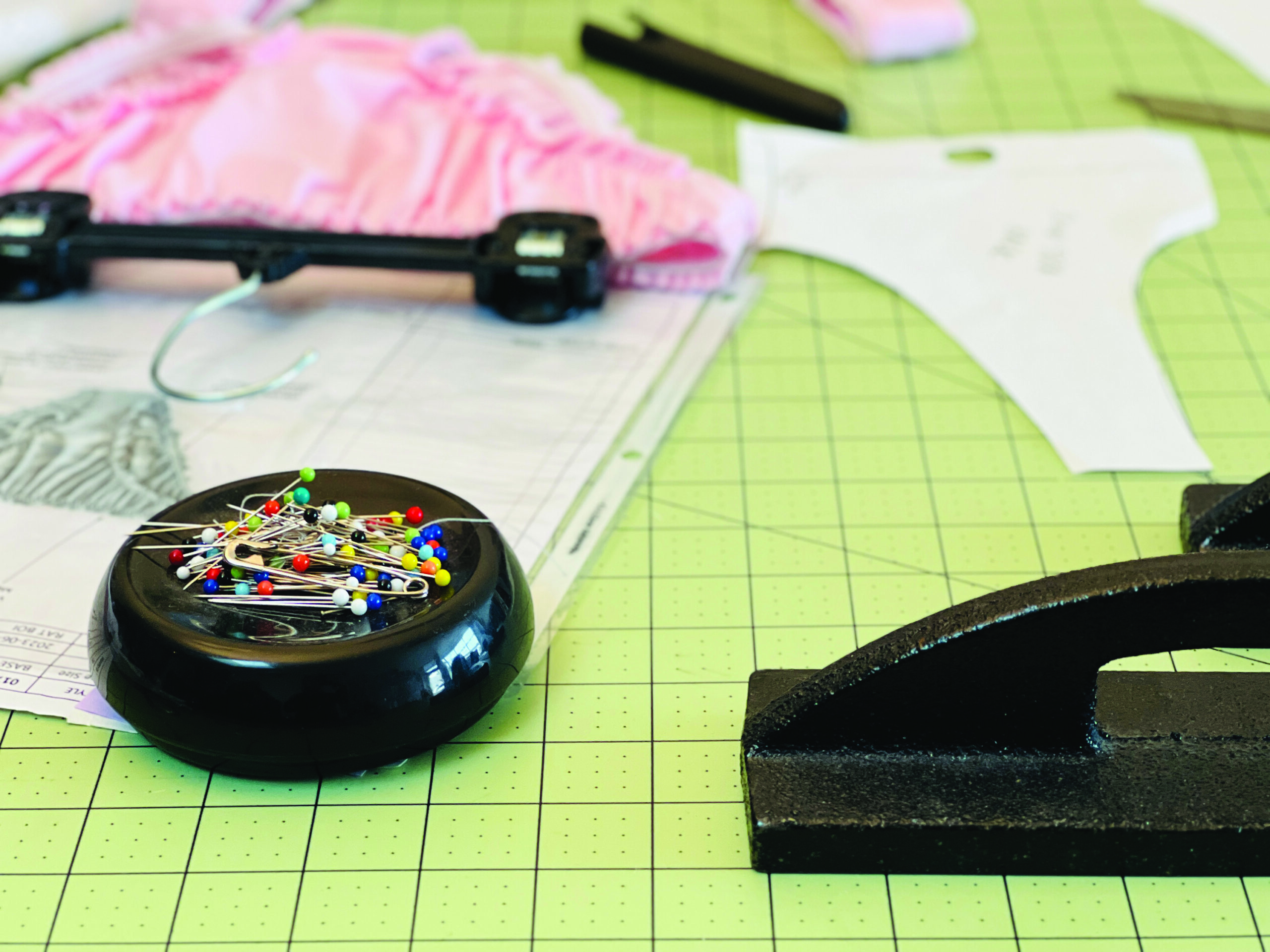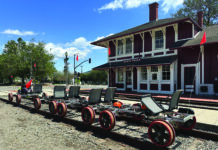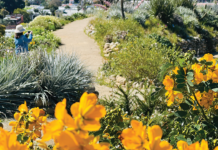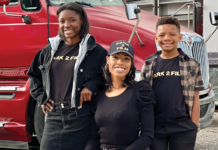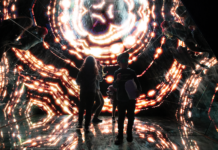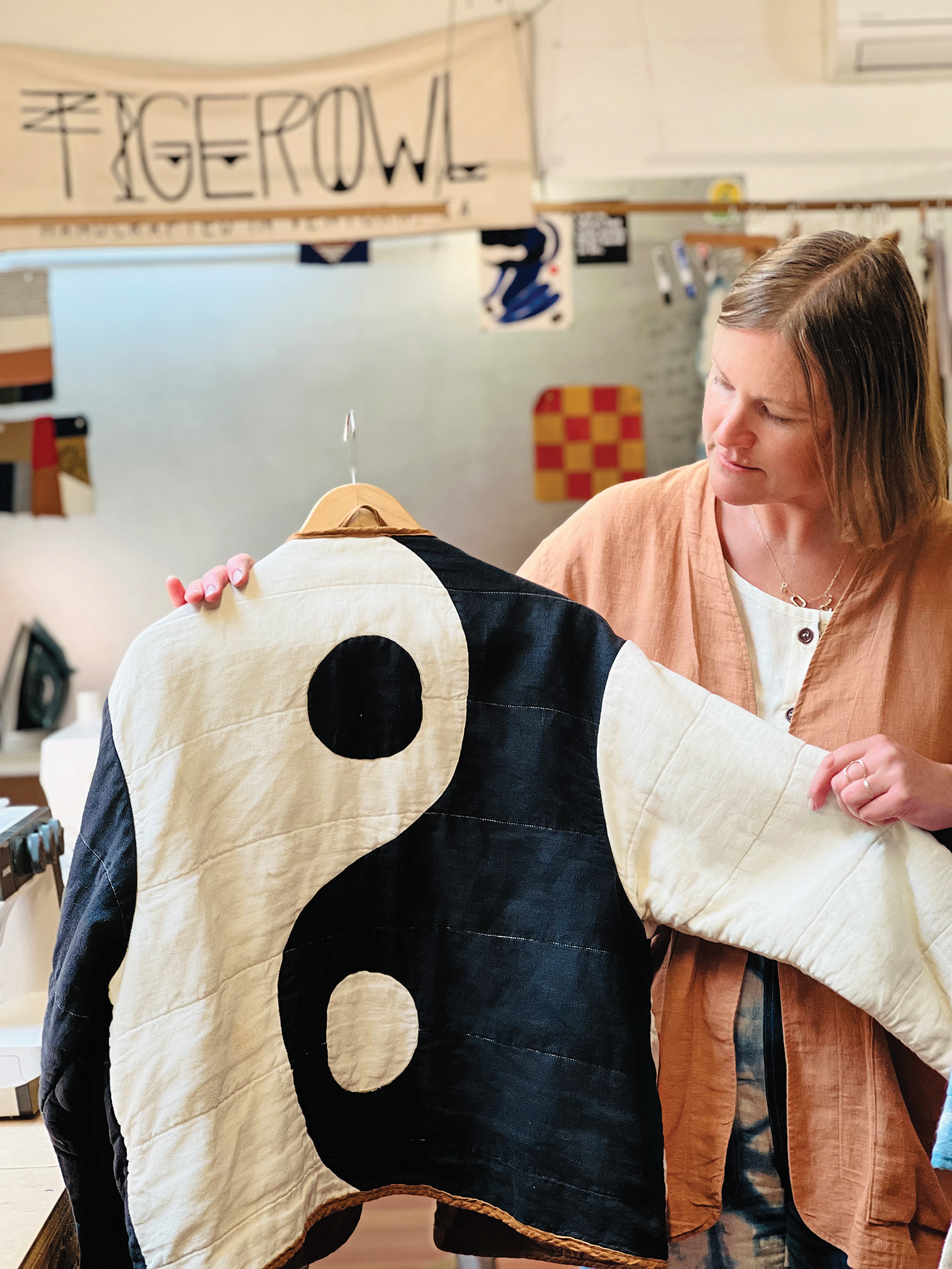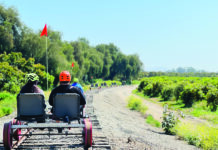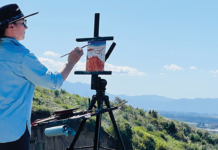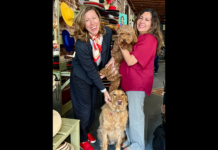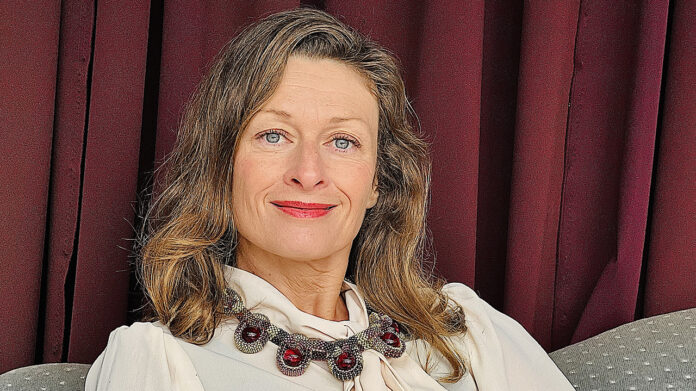Talking art, Italy, the magic of creation and “stretching the creative cord” with bead artist Mara Colecchia.
By Nancy D. Lackey Shaffer | Photos by Viktor Budnik
From a young age, Mara Colecchia was steeped in art. She grew up in the picturesque Italian city of Urbino – a World Heritage Site notable for medieval architecture, majolica pottery and its many artists, including Raphael. She is related to the Palizzi family of painters, has an aunt that was a hatmaker and, as a child, enjoyed drawing scenes inspired by her favorite stories. After working as an illustrator and animator in Rome, she came to Los Angeles to seek her fortune and made her way to Ojai. Today, she is a passionate bead artist whose work has been featured in fashion magazines, galleries and museums around the world, including the Ojai Art Center.
Despite busily preparing for an art show in Portugal this spring, and a jewelry show in Florida this month, Colecchia found time to answer some questions from Ventana Monthly about her life in Italy, her numerous creative endeavors, getting hooked on beads and more.
You’re originally from Italy. Where did you grow up?
I grew up in Urbino, a small art town in the mid-eastern side of the peninsula, famous for a popular Renaissance patron, the Duke of Montefeltro, and also for its winter truffles.
Were any of your family members artists?
On my mom’s side. The Palizzi brothers (Giuseppe and Filippo) were my grandma’s cousins, and as a child I admired their paintings hanging at my grandparents’ house in southern Italy, and also some etchings from their students. My mom still has a few in her apartment and I feel like those artists are part of the family, even though I have never got to meet them. Also, one of my mom’s aunties was a modiste (she was making hats) and my grandma was a master of knitting. I think that maybe I inherited from them my natural proclivity for stitching. Who knows…
What inspired you to study illustration and animation at Scuola del Libro?
I have always been creating, since an early age, and I was lucky enough to be encouraged by my parents to take classes in many different media. Once I even took a class in mask making, held by a renowned artist from Venice, which I truly enjoyed.
As I graduated from classic literature high school, with the highest grade, my parents, who were both teachers, expected me to pursue an academic career. After a year spent in college, I became very depressed and I decided to quit. I felt that life was already too hard to have such low expectations of enjoying it: Better to have fun and keep creating things that make people smile! I believe that my first form of expression as a child was drawing and illustrating short stories, so at the time pursuing a career as an illustrator of children’s literature felt quite natural. I felt that I was honoring my true nature; my inner child, so to speak.
For many people, the idea of residing in a picturesque and historic city like Urbino is truly living the dream! What was it like to live and study there as a young woman?
Well, we spent every summer by the beach, so I feel very much like a Californian: I enjoyed the hills and the snow in winter, our magical countryside in autumn and spring, and the Adriatic Sea on the hottest days. We got just about everything when it comes to natural scenery and, on the other end, there was quite a vibrant cultural scene to be inspired by. Just to mention one: The part of my county that is by the sea, Pesaro, is the hometown of both Gioachino Rossini and Luciano Pavarotti, and it hosts one of the best Opera Festivals in the country.
My years at La Scuola del Libro were filled with restless experimental creations, and in the initial two years many of the classes were held inside the castle of the duke. We actually had to walk up through the horses’ ramp in the morning to reach the highest level of the palace, as there was no elevator. It was like living inside a set of some period movie. Thinking about it now, I consider myself privileged: I was not coming from money, but in a way I had benefited from all the things that my country could offer…including the great food.
Tell us about your animation work. What were some of your projects?
I worked in Rome on several Italian productions that are unknown to the USA. In Los Angeles, I worked briefly for an animation studio that was partnering with the Italian production Geronimo Stilton [a children’s chapter book series by Elisabetta Dami]. I believe that many American children love Geronimo, and so do I.
You moved to Southern California from Rome in 2009. What brought you here?
I moved to Los Angeles mostly out of frustration. I was tired of dealing with the lack of professionalism in an industry that was already dying at the time, in my country. I needed to think big and to push my limits. Or at least I thought so.
The story that brought me here is actually pretty meaningful in terms of synchronicity: I got into a small accident with my Vespa, in Rome, and I managed to get reimbursed 3,000 Euro. At the time the U.S. dollar was at its lowest, and I was able to almost duplicate that amount of money when I converted it into dollars. I was then able to apply for an eight-week screenwriting class at the New York Film Academy in Burbank, and planned to live there for two months. Of course my life changed drastically and I stayed longer. But this is another story…
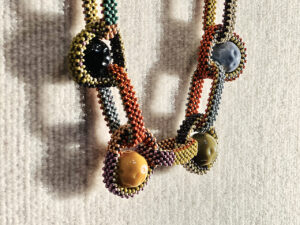
What brought you to Ojai?
I moved to Ojai after nine years in Los Angeles, when life over there was becoming pretty uncomfortable, especially due to the painful isolation and the heavy traffic, that made each day a true pain to go through. It came to the point where I was spending about four hours a day in my car. I realized that I was being really stupid living like that, and that I needed to let go. I looked for an alternative place to relocate, one that was close enough to be able to visit L.A. when I needed to. Ojai came to my attention because a friend was living there and so I had plenty of opportunities to go visiting and explore the potential.
What do you like about living in Ojai?
I love the nature, of course, the breathtaking wilderness and the power of the mountains. I can feel it: It’s a deep-rooted energy that wraps around people like a cocoon. It feels protective, in a way.
I can’t compare Ojai to any place in Italy, because even though appearances can say the opposite, it’s way too different at the core. I have heard that California is considered the Puglia of the USA, because some of the natural spots resemble Mediterranean sites, and I agree with that; but the cultural heritage is way too different to compare. Italy is closer [in ambience] to Mexico, for instance, than any place in California. In fact, when I visit Mexico I feel instantly at home, for some reason.
There is a certain type of lifestyle that involves much more human connection and walking through streets and plazas that are human size, a misura d’uomo, like we say in Italy. When I am visiting my hometown, for instance, I would have a friend buzz me after dinner (9 p.m. over there) to come down for a walk and a coffee chat. Social life goes on for longer hours in Southern Europe, and I miss that very much, to be honest.
Why did you decide to make the switch from animation to wearable art and jewelry?
I did not decide: It happened gradually and naturally. I was invited to join my very first group show in Downtown L.A., in May 2011 (I still remember it), at the gallery The Hive. At the time I was creating dioramic installations with plush dolls that functioned as illustrations of my children’s stories, so I was still expressing myself as a storyteller, matter of fact. Just, the size was larger.
I can still remember how excited I was at the opportunity to exhibit my work of art as a legitimate artist. I realized how much I was craving that experience, probably without knowing it. A few years and many accomplishments later I switched again, from visual to wearable art, and that also happened organically.
What media did you use when you were first making jewelry?
My very first experiment was a 3D printed Venetian nose ornament, which led to a series of other experiments with textiles (hats and masks). I still have a few of those and enjoy those designs very much.
When did you start working with beads?
I started in 2018, at the time of the Thomas Fire. I was evacuated to Los Angeles, where I stayed for a month, while the fire was slowly tamed. In that period of time I felt restless and obviously anxious, so I felt the need to try something new. So I took a beading class and something clicked. It was as if the fire had unraveled some transformative energy that was kept on hold and gave space to something new to emerge. I would have never thought that beads could become my main medium. It was very surprising.
Do you do custom work? What are some of the more interesting projects you’ve been commissioned to create?
I do take commissions, mostly through art exhibits and Instagram promotions. I also create pieces for themed exhibitions, like “Cross,” that I made specifically for the exhibit Artifactual Remakes, organized by the Baltimore Jewelry Center and the Walters Art Museum, in 2021. We were given a choice between many ancient jewelry, and I chose a Renaissance cross pendant. The idea was to remake the piece in a contemporary guise. I was very pleased with what I created, especially because I would have never thought of making a cross that way if it wasn’t suggested to me.
I also enjoy creating pieces for artist residencies, where I simply surrender to some meaningful concept that wants to emerge from within. You can never plan a design, when you embark in an artist residency. It is the place and the people around you that contribute to the manifestation of that special creation that was meant to exist at that time and space. It’s a magical process, comparable maybe only to ceramic making: One can never know what is coming out of the kiln.
What types of beads do you utilize in your art? What appeals to you about them?
I use exclusively size 11 and size 15 seed beads, which are extremely small and allow me to create a sturdy bead mesh, with a tiny texture. I am trying to pursue a sleek look and larger beads would not suit me. They are mostly Japanese Toho, metallic and ceramic coated. I love the ceramic type because the colors look so full and the texture confers a toy-like personality to my pieces. Both the metallic and the ceramic type can be pretty expensive, although there is a misconception about beads to be cheap. Most of the larger pieces in my collections are more costly for me to make than some common metalsmith work, but for some reason people still believe that metal is more valuable. Not sure why. Speaking of which, I also utilize 24K gold electroplated Czech beads, Charlotte cut, which is extremely rare. I have to hunt for these beads, at times, and it’s all part of the process. Every piece that I make is unique also for the rarity of the beads utilized.
Where do you source your materials?
I buy everything online, including rare findings such as the many vintage beads that I use as gemstones in my designs. I tried some beads expos, but I have always been disappointed; one can find much more online these days.
I am actually obsessed with spherical beads and my collection has grown exponentially during the pandemic. I mean, what else was I going to do with all that time in my hands? I definitely bought more than I can handle. It would take me probably five years of work to utilize all the beads that I have in stock at the moment. It’s almost embarrassing.
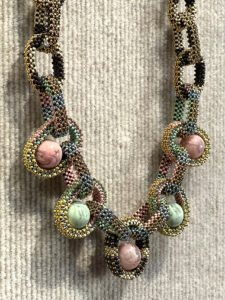
Describe some of the more unusual items you have made.
This question makes me reflect on the meaning of the word unusual. I never make things that I would find usual. First of all because ornaments, as well as sculptures, fulfill no purpose other than the pursuit of beauty. So the very act of creating something that has no function is unusual.
Then, if I was asked if I ever made something that was unusual for me, that was going really off the chart with regards to my habitual choices, I can say with absolute certainty: no, I didn’t. Because every time that I tell myself “try to create something normal, this time, something that you can actually sell,” it always turns into an incredible journey towards some sort of discovery, and the final piece is not at all what I had planned. I am quite often surprised at what I create unintentionally.
It’s very strange: Objects that need to emerge through me will always find their way to do it, and I am not in charge of the process. It sounds pretentious, but I mean it.
What is your process like? Where do you find inspiration for your designs?
I could define myself as a formalist, in the sense that my inspiration always originates from the medium. A color, a shape, a particular texture can evoke a concept. I frequently start from the vintage bead that will serve as a gemstone and I go from there.
Sometimes I have intuition about a combination of colors of beads, like a melancholic feeling for something that was part of my childhood, for instance. To give you a sample, my piece “Arcadia,” acquired by Hannah Gallery in 2020, started from my absolute obsession for some corn yellow seed beads that I purchased. I noticed that when paired to firetruck red Miyuki seed beads they would immediately send me back to my childhood. Not sure what it was… so I paired them with some vintage spheres that look like fragmented mosaics in primary colors. Some concept started to emerge, as I discovered that the mesh I was creating with these beads was resembling the pixelation of some video game that I was playing at the Arcade in the ’80s. I magically reconnected to something that I had lost: red and yellow were in fact frequently paired in the graphics of those vintage video games. This is also where the title comes from: Arcadia.
Another good sample of this process of association is my playful design named “Creaturo,” which resembles a character from some paintings by Gary Baseman. I came up with a chunky, sleek, black and white dynamic, with three spheres aligned in a row; as I added two dangling spheres side by side, I immediately saw the arms of a character hanging upside down. I could not resist extruding fingers from the dangling spheres, and before my very eyes a character was born.
What are you working on right now?
At the moment I am working on a jewelry set for the art gallery Collectiva in Porto, Portugal, where I have an upcoming exhibit. It’s a design inspired by Hispanic art and a childhood narrative, and I am naming it “Las Meninas.” It’s basically a personal interpretation of that lovely shape of little girls’ gowns in the homonymous painting by Diego Velazquez, which has been largely explored by other artists over decades, Picasso included. It’s been hard to find materials for this jewelry set, though, as the main type of beads I use are 24K electroplated gold Czech seed beads, Charlotte cut (meaning that one side of the bead is flat). Apparently there is a shortage of these beads in the U.S. at the moment, which caused me to have to pay double the price to acquire the few grams left. I guess it’s part of the game.
Do you have a particular type of bead or stone that you really love? If so, why?
Beside my profound appreciation for lucite (an industrial resin developed in Italy back in the 1970s), I am intrigued by natural stones. I developed an interest in crystals as I began to benefit from Reiki sessions and crystal healing a few years ago. I am getting to know crystals’ properties, appreciating their nuances, the crackles and irregularities of their surfaces. I have a taste for minimal designs, so I gravitate towards simple natural shapes or very sleek geometric carvings. Of course, being obsessed both with spheres and black crystals, the most attractive to me at this point are a couple of large black tourmalines that someone gave me. I wish I could drill them and make a super large necklace, or a pair of insanely heavy earrings!
Do you have other artistic endeavors besides your beadwork?
I always keep my door open to new opportunities and learning experiences. I think of wearable art on a large scale, so I explore different ways to make wearables, in a more artistic and experimental way. Such as, for example, my series of brooches made with balloons and sequins, assembled with staples. I like to explore various media, and that’s why I am frequently attending classes, even though in most of the cases I won’t continue developing that specific technique. It’s all part of the creative process: stretching the creative cord, so to speak.
One thing that many people don’t know about me is that I am an excellent tarot reader. If you consider it a form of art, of course. I learned the Jodorowsky method during the pandemic and I keep learning from Alejandro’s publications and videos. I am absolutely intrigued by the whole concept of healing personal conflicts though Psychomagic practices. And my ambition of course is to become the highest form of an artist: a shaman.
Where can people find Mara Colecchia originals?
One of my pieces from 2020 has been recently acquired by the Museum of Beadwork in Portland, Maine, and I am frequently part of collective exhibits in Europe and China. You can find all the information on the latest exhibits on my Instagram page @maracole_artwear, while on my website maracole.com there are plenty of photos of the collections created so far.
Any interesting shows, projects or plans on the horizon?
I am headed to a big jewelry show held by the Boca Raton Museum of Art in Florida starting March 20. The event is named “Bijoux!” and is directed by Donna Schneider. I am truly excited about it, especially because fashion icon Iris Apfel will attend as a special guest. I also have an upcoming personal exhibit at the gallery Collectiva in Porto, from May to July, and I am possibly taking part in a larger trade show in Barcelona,
Contemporanea, happening at the end of September. That is how far I go for the moment.
@maracole_artwear



